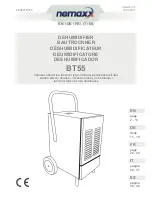
Blastmaster
®
950 CFM Air Dryer
3
Failure to comply with ANY WARNING listed below could result in death or serious injury.
OSHA sets exposure limits to protect workers from exposure to respirable crystalline silica, 29 CFR 1910.1053.
Airborne dust could increase the exposure levels beyond permissible limits. Breathing dust containing silica
could cause silicosis, a fatal lung disease. Breathing dust during abrasive blasting operations, post-blast cleaning
operations, and/or servicing equipment within the abrasive blasting area may expose an individual to conditions
that could cause asbestosis, lead poisoning and/or other serious or fatal diseases. Harmful dust containing toxic
material from abrasives or surfaces being abrasive blasted can remain suspended in the air for long periods of
time after abrasive blasting has ceased. A NIOSH-approved, well-maintained, respirator designed for the specific
operation being performed must be used by anyone abrasive blasting, handling or using the abrasive, and
anyone in the area of the dust.
Contact NIOSH and OSHA offices to determine the proper respirator for your specific application. The air supplied
to the respirator must be at least Grade D quality as described in Compressed Gas Association Commodity
Specification G-7.1 and as specified by OSHA Regulation 1910.134. Ensure air filter and respirator system hoses
are not connected to non-air sources or in-plant lines that may contain nitrogen, oxygen, acetylene or other
non-breathable gases. Before removing respirator, use an air monitoring instrument to determine if the
atmosphere is safe to breathe.
You must comply with all OSHA, local, City, State, Province, Country and jurisdiction regulations, ordinances and
standards, related to your particular work area and environment. Keep unprotected individuals out of the work
area.
Abrasive blasting operators must receive thorough training on the use of abrasive resistant attire which includes:
supplied-air respirator, abrasive blasting suit, safety shoes, gloves, ear protection and eye protection. Protect the
operator and bystanders by complying with NIOSH and OSHA Safety Standards.
Inspect all equipment for wear or damage before and after each use. Failure to use Original Equipment
Manufacturer repair parts and failure to immediately replace worn or damaged components could void warranties
and cause malfunctions.
OSHA requires abrasive blasting nozzles be equipped with an operating valve, which shall be designed to be
held open only by continuous hand pressure and shall close immediately upon release of hand pressure (i.e., a
“deadman” control). The valve shall not be modified in any manner that would allow it to remain open without the
application of continuous hand pressure by the operator. Failure to comply with the above warning could result in
release of high speed abrasive and compressed air resulting in death or serious injury. OSHA 29CFR 1910.244(b)
Point the abrasive blasting nozzle only at the surface being abrasive blasted. Never point the abrasive blasting
nozzle or abrasive stream at yourself or others.
Unless otherwise specified, maximum working pressure of abrasive blasting pots and related components must
not exceed 150 psi. Exceeding maximum working pressure of 150 psi could cause the abrasive blasting pot and
components to burst. Failure to comply with the above warning could result in death or serious injury.
Never weld, grind or drill on the abrasive blasting pot (or any pressure vessel). Doing so will void ASME
certification and manufacturer’s warranty. Welding, grinding or drilling on the abrasive blasting pot (or any pressure
vessel) could weaken the vessel causing it to burst. Failure to comply with the above warning could result in death
or serious injury. (ASME Pressure Vessel Code, Section VIII, Division 1)
This equipment is not intended for use in any area that might be considered a hazardous location, as described
in the National Electric Code NFPA 70, Article 500. Use of this equipment in a hazardous location could cause an
explosion or electrocution.
Never attempt to move an abrasive blasting pot containing abrasive. Never attempt to manually move abrasive
blasting pots greater than 6.5 cubic foot capacity. Always use at least two capable people to manually move an
abrasive blasting pot on flat, smooth surfaces. A mechanical lifting device must be used if an abrasive blasting pot
is moved in any other manner.
HAZARD IDENTIFICATIONS
Summary of Contents for Blastmaster 950 CFM
Page 11: ...Blastmaster 950 CFM Air Dryer 10 OPERATING INSTRUCTIONS Pneumatic Electric...
Page 13: ...Blastmaster 950 CFM Air Dryer 12 OPERATING INSTRUCTIONS 10 11 6 1 2 3 4 5 15 12 13 14 16 7 8 9...
Page 15: ...Blastmaster 950 CFM Air Dryer 14 OPERATING INSTRUCTIONS 1 12 13 2 3 4 5 6 7 8 9 10 11...
Page 30: ...Blastmaster 950 CFM Air Dryer 29 DATE TYPE OF SERVICE PART NUMBER MAINTENANCE NOTES...





































